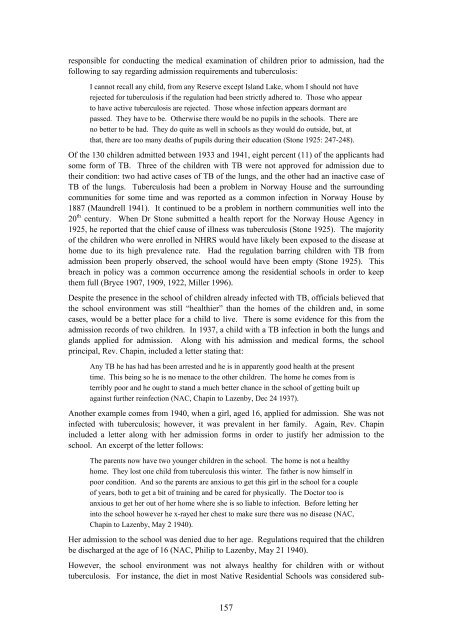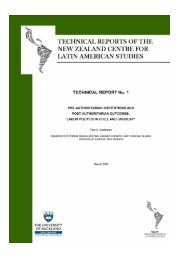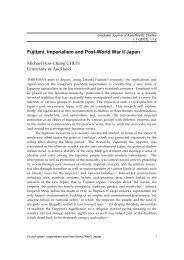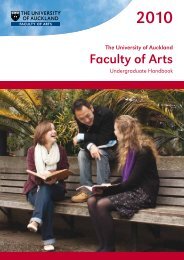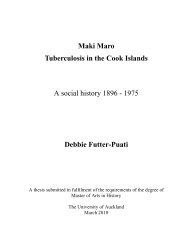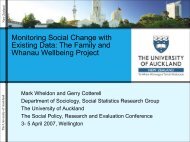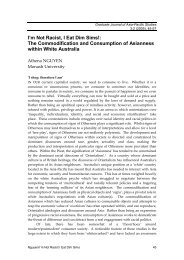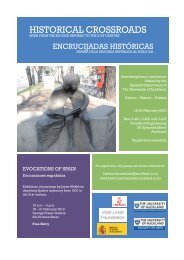esponsible for conducting the medical examination <strong>of</strong> children prior to admission, had thefollowing to say regarding admission requirements <strong>and</strong> tuberculosis:I cannot recall any child, from any Reserve except Isl<strong>and</strong> Lake, whom I should not haverejected for tuberculosis if the regulation had been strictly adhered to. Those who appearto have active tuberculosis are rejected. Those whose infection appears dormant arepassed. <strong>The</strong>y have to be. Otherwise there would be no pupils in the schools. <strong>The</strong>re areno better to be had. <strong>The</strong>y do quite as well in schools as they would do outside, but, atthat, there are too many deaths <strong>of</strong> pupils during their education (Stone 1925: 247-248).Of the 130 children admitted between 1933 <strong>and</strong> 1941, eight percent (11) <strong>of</strong> the applicants hadsome form <strong>of</strong> TB. Three <strong>of</strong> the children with TB were not approved for admission due totheir condition: two had active cases <strong>of</strong> TB <strong>of</strong> the lungs, <strong>and</strong> the other had an inactive case <strong>of</strong>TB <strong>of</strong> the lungs. Tuberculosis had been a problem in Norway House <strong>and</strong> the surroundingcommunities for some time <strong>and</strong> was reported as a common infection in Norway House by1887 (Maundrell 1941). It continued to be a problem in northern communities well into the20 th century. When Dr Stone submitted a health report for the Norway House Agency in1925, he reported that the chief cause <strong>of</strong> illness was tuberculosis (Stone 1925). <strong>The</strong> majority<strong>of</strong> the children who were enrolled in NHRS would have likely been exposed to the disease athome due to its high prevalence rate. Had the regulation barring children with TB fromadmission been properly observed, the school would have been empty (Stone 1925). Thisbreach in policy was a common occurrence among the residential schools in order to keepthem full (Bryce 1907, 1909, 1922, Miller 1996).Despite the presence in the school <strong>of</strong> children already infected with TB, <strong>of</strong>ficials believed thatthe school environment was still “healthier” than the homes <strong>of</strong> the children <strong>and</strong>, in somecases, would be a better place for a child to live. <strong>The</strong>re is some evidence for this from theadmission records <strong>of</strong> two children. In 1937, a child with a TB infection in both the lungs <strong>and</strong>gl<strong>and</strong>s applied for admission. Along with his admission <strong>and</strong> medical forms, the schoolprincipal, Rev. Chapin, included a letter stating that:Any TB he has had has been arrested <strong>and</strong> he is in apparently good health at the presenttime. This being so he is no menace to the other children. <strong>The</strong> home he comes from isterribly poor <strong>and</strong> he ought to st<strong>and</strong> a much better chance in the school <strong>of</strong> getting built upagainst further reinfection (NAC, Chapin to Lazenby, Dec 24 1937).Another example comes from 1940, when a girl, aged 16, applied for admission. She was notinfected with tuberculosis; however, it was prevalent in her family. Again, Rev. Chapinincluded a letter along with her admission forms in order to justify her admission to theschool. An excerpt <strong>of</strong> the letter follows:<strong>The</strong> parents now have two younger children in the school. <strong>The</strong> home is not a healthyhome. <strong>The</strong>y lost one child from tuberculosis this winter. <strong>The</strong> father is now himself inpoor condition. And so the parents are anxious to get this girl in the school for a couple<strong>of</strong> years, both to get a bit <strong>of</strong> training <strong>and</strong> be cared for physically. <strong>The</strong> Doctor too isanxious to get her out <strong>of</strong> her home where she is so liable to infection. Before letting herinto the school however he x-rayed her chest to make sure there was no disease (NAC,Chapin to Lazenby, May 2 1940).Her admission to the school was denied due to her age. Regulations required that the childrenbe discharged at the age <strong>of</strong> 16 (NAC, Philip to Lazenby, May 21 1940).However, the school environment was not always healthy for children with or withouttuberculosis. For instance, the diet in most Native Residential Schools was considered sub-157
par <strong>and</strong> contributed to the children’s susceptibility to disease, particularly tuberculosis (Miller1996). <strong>The</strong> food was usually <strong>of</strong> poor quality, inadequate quantity, <strong>and</strong> lacked the varietyneeded to provide all the necessary nutrients. It was not uncommon for doctors to sendreports to the DIA on the relationship that they observed between the poor diet in the schools<strong>and</strong> tuberculosis among the school children (RCAP 1996a).At the NHRS, numerous complaints about the food led to an investigation <strong>of</strong> the diet by twoDIA <strong>of</strong>ficials in 1915. <strong>The</strong> local Indian Agent was the first to investigate at the beginning <strong>of</strong>the year. He claimed that the food was “good <strong>and</strong> substantial” <strong>and</strong> that there were no groundsfor the complaints. He essentially claimed that the children were complaining for the sake <strong>of</strong>it (NAC, Report on complaints, Jan 6 1915). However, due to continuing complaints, JohnBunn, the Inspector <strong>of</strong> Indian Agencies, conducted a second investigation later in the year.His results differed greatly from the Indian Agent’s report. As part <strong>of</strong> his report, the schoolprincipal had to submit a copy <strong>of</strong> the school menu (Table 3).Table 3 Menu <strong>of</strong> the NHRS for 1915 (Source: NAC, RG 10 Vol 6268, file 581-1, part 1).Day Morning Breakfast Noon Dinner Night SupperSundayMondayTuesdayWednesdayThursdayFridaySaturdayGranules Porridge,Bread & TeaBaked Beans, Bread &TeaOatmeal Porridge,Bread & TeaGranules Porridge,Bread & TeaOatmeal Porridge,Bread & TeaOatmeal Porridge,Bread & TeaOatmeal Porridge,Bread & TeaPork & Beans, Pie, Bread& WaterFish or Meat, Bread &WaterFish or Meat & Rice,Bread & WaterFish or Meat, Split Peas,Bread & WaterFish or Meat, Pot BarleyBread & WaterFish or Meat, Bread &WaterFish, Bread & WaterBread & Jam, TeaFish, Bread & TeaPrunes, Bread &TeaFish, Bread & TeaApples, Bread &TeaFish, Bread & TeaBread, Butter &Tea<strong>The</strong> Fish or Meat is to be boiled with some <strong>of</strong> the dried vegetables mentioned abovePies are made once a week, 1 1/2 lb Lard to a making, pie cuts in 6 piecesFor a change the Fish or Meat may be fried or roastedYellow sugar to be used in tea, night <strong>and</strong> morning, also in stewing apples or making piesYellow sugar, with syrup every alternate morning, served on PorridgeWhen fish or meat is not in stock, dried vegetables, as the Principal may direct, may be usedFish: <strong>The</strong>se are White [Fish], Pickerel, Pike, Gold Eyes, Sturgeon, Red <strong>and</strong> Grey SuckersMeat: This if Beef, Moose Meat, VenisonVegetables: Beans, Split Peas (dried)Cereals: Rolled Oats, Granules, Pot Barley, RiceAccording to Bunn’s findings, the quality <strong>of</strong> bread was “open to criticism,” the quality <strong>of</strong> fishwas not always the best <strong>and</strong> sometimes poorly cooked, there was an absence <strong>of</strong> fatty food, <strong>and</strong>there was a limited quantity <strong>of</strong> vegetables. <strong>The</strong> only available vegetables were turnips, beets,cabbage, <strong>and</strong> carrots. Potatoes were available at the beginning <strong>of</strong> the year but were only used forfour meals (NAC, Bunn to Scott, Sept 24 1915). In addition, the local doctor, Dr. Norquay,158
- Page 1 and 2:
RESEARCH IN ANTHROPOLOGY & LINGUIST
- Page 3 and 4:
The University of Auckland acknowle
- Page 5 and 6:
Part 3 Living with TuberculosisIntr
- Page 7:
The workshopOur productive and stim
- Page 10 and 11:
Part 1 Unpacking TuberculosisIntrod
- Page 12 and 13:
ReferencesAscione, F., 2005. Childr
- Page 14 and 15:
Cases of active TB disease were def
- Page 16 and 17:
40.035.0Age-specific incidence rate
- Page 18 and 19:
2001-06 the incidence rate for thos
- Page 20 and 21:
incidence rates for foreign-born pe
- Page 22 and 23:
that cases for whom the diagnosis o
- Page 24 and 25:
Voss, L., M. Campbell, C. Tildesley
- Page 26 and 27:
Figure 1Views of the 5th metacarpal
- Page 28 and 29:
when, in reality, recently transmit
- Page 30 and 31:
over” host (Morris et al 1994:172
- Page 32 and 33:
de Lisle, Geoffery W., C. G. Mackin
- Page 34 and 35:
Chapter 3The Political Ecology of T
- Page 36 and 37:
social networks (particularly for o
- Page 38 and 39:
community. However, as Anderson’s
- Page 40 and 41:
2004. Over this period the rate of
- Page 42 and 43:
the people interviewed had access t
- Page 44 and 45:
of household crowding or income ine
- Page 46 and 47:
Chapter 4Tuberculosis and Syndemics
- Page 48 and 49:
patterns. The authors examined “a
- Page 50 and 51:
Partners of Manitoba that explored
- Page 52 and 53:
The Point Douglas CA is 10.9 square
- Page 54 and 55:
Table 2Selected social determinants
- Page 56 and 57:
Rhodes, Tim, Merrill Singer, Philip
- Page 58 and 59:
During the four years since our pro
- Page 60 and 61:
under which a person who has had la
- Page 62 and 63:
groups in New Zealand that promotes
- Page 64 and 65:
Littleton, J., J. Park, C. Thornley
- Page 66 and 67:
Nair 1997, Geetakrishnan 1988, Puro
- Page 68 and 69:
with peer review, group work and re
- Page 70 and 71:
of TB cases. TANI became aware of t
- Page 72 and 73:
The programme has been successful i
- Page 74 and 75:
Chapter 7The Treaty of Waitangi Pri
- Page 76 and 77:
Given the apparent limitations of H
- Page 78 and 79:
delayed TB diagnosis and inappropri
- Page 80 and 81:
Six participants believed they had
- Page 82 and 83:
strategies, acknowledging different
- Page 84 and 85:
Hayward, Janine, 1997. Appendix: Th
- Page 86 and 87:
Chapter 8Matching Research with Evi
- Page 88 and 89:
problem in Aboriginal communities w
- Page 90 and 91:
officials advised community members
- Page 92 and 93:
ResultsThe MEDLINE search generated
- Page 94 and 95:
Gibson et al. 2005 X XCook et al. 2
- Page 96 and 97:
in rates will likely be achieved on
- Page 98 and 99:
Daschuk, J.W., Hackett, P., MacNeil
- Page 100 and 101:
Ontario Lung Association, 2003. Tub
- Page 102 and 103:
Part 2 Reproducing TuberculosisIntr
- Page 104 and 105:
particular focus on the quality of
- Page 106 and 107:
Chapter 9The Contribution of Tuberc
- Page 108 and 109:
years of civilian mortality registr
- Page 110 and 111: Soldiers’ mortality rates from al
- Page 112 and 113: While fluctuations in mortality can
- Page 114 and 115: continue, perhaps to a very small p
- Page 116 and 117: Chapter 10Tuberculosis Mortality am
- Page 118 and 119: schools. This forced school officia
- Page 120 and 121: Figure 2 Residential Schools and Re
- Page 122 and 123: Figure 3 Manitoba TB treatment faci
- Page 124 and 125: attend classes on forty of the seve
- Page 126 and 127: Again, this was hardly a shocking d
- Page 128 and 129: Figure 51949 TB Survey.Indian Affai
- Page 130 and 131: In December of 1943 the Canadian Tu
- Page 132 and 133: communities and sent south to dista
- Page 134 and 135: 3 LAC RG 10, Volume 3855, File 7996
- Page 136 and 137: 60 Tuberculosis Control in Manitoba
- Page 138 and 139: This article examines patterns of d
- Page 140 and 141: dying of consumption, that great en
- Page 142 and 143: Study of mortality seasonality reve
- Page 144 and 145: Recognizing the cumulative biologic
- Page 146 and 147: Crowded living quarters provided an
- Page 148 and 149: ReferencesAmerican Lung Association
- Page 150 and 151: Stephens, Christianne V., 2004. A p
- Page 152 and 153: Chapter 12Norway House Residential
- Page 154 and 155: thought that Brandon was too far aw
- Page 156 and 157: Tuberculosis in Norway House Reside
- Page 158 and 159: The greatest number of deaths, almo
- Page 162 and 163: informed Bunn that he had treated s
- Page 164 and 165: Hardiman EF. 1902. Principal’s Re
- Page 166 and 167: Chapter 13A Political Ecological Pe
- Page 168 and 169: Figure 2Whakarewarewa in the 1920s.
- Page 170 and 171: Comparison of the housing condition
- Page 172 and 173: 1920s, was the government finally c
- Page 174 and 175: dilapidated. They were observed als
- Page 176 and 177: ReferencesAllen, A.E. and D.G. Phil
- Page 178 and 179: Wang, P.D. and R.S. Lin, 2000. Tube
- Page 180 and 181: ejection from within their family o
- Page 182 and 183: Chapter 14The Bright Light of Actio
- Page 184 and 185: environment” 18 of Taranaki Maori
- Page 186 and 187: In the face of ongoing complaints a
- Page 188 and 189: Fitzgerald, Criena, 2002. Making tu
- Page 190 and 191: Chapter 15Pakeha and Tuberculosis i
- Page 192 and 193: understand vulnerability and suppor
- Page 194 and 195: around when she first had TB knew t
- Page 196 and 197: An article from the Dominion newspa
- Page 198 and 199: Scheper-Hughes, N., 1992. Death Wit
- Page 200 and 201: Tuberculosis: A disease of othersTh
- Page 202 and 203: Tuberculosis and infectionTuberculo
- Page 204 and 205: secondly, the tuberculosis sufferer
- Page 206 and 207: Bhadrak, an Indian man in his 20s,
- Page 208 and 209: Chapter 17Health, Wellbeing and Dia
- Page 210 and 211:
Somalia (Lillebaek et al. 2002:682)
- Page 212 and 213:
carried out. I also interacted with
- Page 214 and 215:
The Auckland Somali population is h
- Page 216 and 217:
mask usually had to be worn by pati
- Page 218 and 219:
understanding of their migration hi
- Page 220 and 221:
Warfa, N., K. Bhui, T. Craig, S. Cu
- Page 222 and 223:
Figure 1New Zealand and its Pacific
- Page 224 and 225:
oth English and Samoan. The second
- Page 226 and 227:
Health cultures and explanations of
- Page 228 and 229:
Duality of TBMany of the older Paci
- Page 230 and 231:
e considered in the ecology of TB,
- Page 232 and 233:
Interviewer: “Do you have any ide
- Page 234 and 235:
McArthur, N., 1965. Island Populati
- Page 236 and 237:
ContributorsAnneka Anderson, Depart
- Page 238 and 239:
Moana Oh (Ngati Rarua, Ngati Toraru
- Page 240:
RAL-e1 Geoarchaeological Investigat


